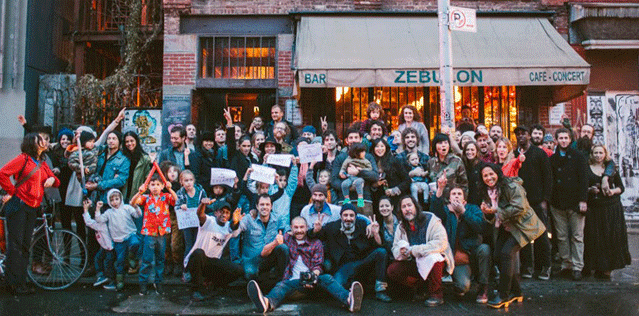

MUSIC
Jesse Lent on the Death of a Great Club
The last time I was at Zebulon, it was packed.
In the eight years that it existed in an old brick building on Wythe Street near Metropolitan Avenue in Williamsburg, Brooklyn, the club had become an intersection point for practically every interesting musical movement born within or passing throughout New York City limits.
In December, Zebulon closed its doors forever, decimated by a new neighborhood regime borne out of Williamsburg’s rapid transformation from artists’ hideaway to hipster haven and finally to young urban professional paradise.
But that night, three days before its demise, Zebulon felt immortal. And everyone inside—even the staff—seemed to want to savor the moment. It was our last dance.
My first experience performing there was in 2008 as a member of CSC Funk Band. Several of my bandmates were regulars and they showed me all of the club’s secret hangs—the basement where we later shot photos for our first album, the fire escape, the backyard. It just had the vibe.
It is hard to know whether CSC Funk Band would even still exist without Zebulon. The owners allowed us to develop our sound on their stage, and it wasn’t always pretty.
Maybe that’s what was so special about that place. Performers were allowed to fail. Playing it safe was discouraged. It was okay for you to fall on your face as long as you did it with conviction.
It was almost like you had an agreement with the audience at Zebulon that went:
“We are going to be trying out some new stuff up here. It could work but it really may not.”
Excuse me, while I kiss the sky.
There aren’t many venues in the city where this kind of experimentation is even allowed, let alone encouraged. And I think it’s important to note that the birth of bebop in the 1940s and the experimental rock scene of the 1960s could not have taken place in New York City without places like that—venues where a musician could play something untested and unpredictable in front of a live audience.
My last night at Zebulon, the duo horn performance of Colin Stetson and Antibalas’s Stuart Bogie embodied that concept—daring improvisation that pushed the limits on several instruments.
It was a set that shouldn’t have been as palatable, as arresting or simply as great as it was. Not that the pair aren’t consummate musicians, but this was raw, two-horn free-form improvisation without accompaniment that held the more than one hundred people jammed into the club and spilling out onto the sidewalk spellbound.
And that night at Zebulon, with its wood paneling and dim lighting reminiscent of the French Revolution, the crowd was cool with each other. Nobody pushed or shoved. Nobody frowned or blurted out any angry drunken words. It was the way it always seemed to be.
As projections of nature tableaus flickered across the backdrop onstage, we all just stood and sighed, sort of like the last 10 minutes before you leave your love forever—painful but sweet.
It was a moment to remind yourself of when it's 15 degrees outside and you're wondering if you should even bother leaving your apartment–when you feel like you've seen it all before. And Stetson and Bogie materialized it out of thin air.
In the 15 years I’ve lived in New York City, there have been three truly great clubs— The Knitting Factory in the early days of its second location on Leonard Street in Tribeca where world-class musicians like Don Byron and Bobby Previte could be seen for free in the tap bar, Elliot Smith’s favorite haunt—Luna Lounge on Ludlow Street on the Lower East Side and Zebulon.
It is no coincidence that all three of those clubs were places you could see top-notch music for free every night of the week.
As a musician performing at such a place, it’s an opportunity for you to get people who haven’t been dragged there to hear you. Audiences at Zebulon would drop in to see who was on. It was a rare chance for them to roll the dice and see something they didn’t know, but something they knew would be worth it.
People don’t often pay a cover to see an act they’ve never heard of before.
There are still a few clubs in the city offering free music (although they seem to diminish every year), but it was the constant musical quality control and risk-taking of Zebulon and those other two venues that made them legendary.
I am of course leaving out CBGBs, a destination that had its day long before I touched down as a bright-eyed youngster in New York City, and all the great DIY venues still standing like Brooklyn’s Secret Project Robot and Death By Audio that provide the city’s final lifeline for non-mainstream music.
When I asked Zebulon co-owner Jocelyn Soubiran (who appears in the top page photo) why he decided to shut down a club that meant so much to so many, he responded:
“When you have a music place, the very last thing you want is to be surrounded by square people. That was the case. The new building next door was complaining every night or so. I want to focus on the sounds, any sounds and not find myself dealing with that kind of bullshit.”
It would appear that the same thing that presumably drew Soubiran’s neighbors to Williamsburg (culture, nightlife) was the first thing they attempted to stamp out once they got here.
I remember sitting on Zebulon’s fire escape over the years and watching the adjoining building swell from a construction site to the luxury enclave it is now. For months after the building appeared complete, it sat vacant.
After the luxury apartments finally filled up with residents, I heard rumors of noise complaints, but never did I think that some concrete and glass eyesore would be the iceberg that sank the ship.
The idea of these new residents moving in above Zebulon and then complaining about the noise, reminds me of a man I encountered in San Francisco when I was busking in the afternoon sun on the corner of Haight Street across the street from the iconic former home of The Grateful Dead.
“Could you keep it down?” the man asked. “I live right there.”
I was alone playing an unamplified acoustic guitar.
It would be nice if those that moved in next door to sonic landmarks like the Grateful Dead’s house or Zebulon could respect what those places mean to people, but that’s not going to happen.
Zebulon was our castle, our playhouse. It was the CBGBs for our time in New York City. Now it’s gone forever, and I can’t help feeling depressed about that.
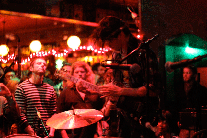
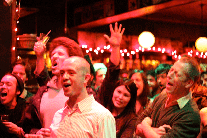
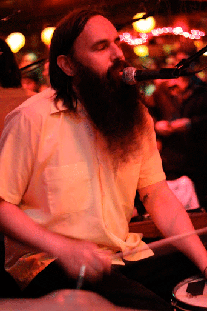
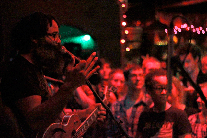
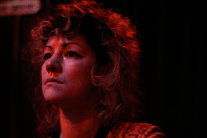
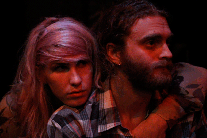
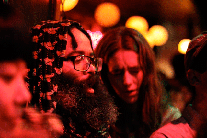
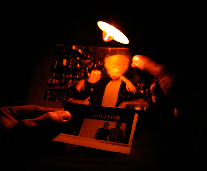
RSS Feed